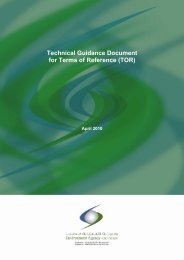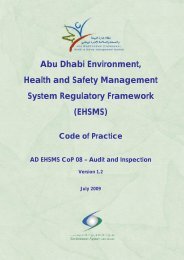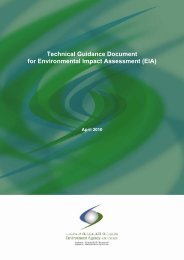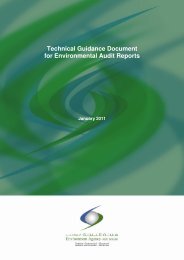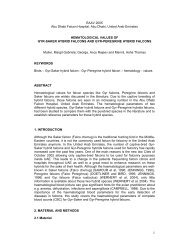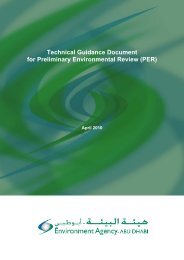Standard Operating Procedures for Permitting of Chemicals and ...
Standard Operating Procedures for Permitting of Chemicals and ...
Standard Operating Procedures for Permitting of Chemicals and ...
Create successful ePaper yourself
Turn your PDF publications into a flip-book with our unique Google optimized e-Paper software.
<strong>St<strong>and</strong>ard</strong> <strong>Operating</strong> <strong>Procedures</strong> <strong>for</strong> <strong>Permitting</strong> <strong>of</strong> <strong>Chemicals</strong> <strong>and</strong> Hazardous Materials in Abu Dhabi<br />
Definition <strong>of</strong> Terms<br />
Auto-ignition Temperature—The minimum temperature required to initiate or cause self-sustained<br />
combustion in any substance in the absence <strong>of</strong> a spark or flame.<br />
Adverse—An abnormal, undesirable, or harmful change.<br />
Carcinogens—Any chemical or substance that is capable <strong>of</strong> causing or inducing cancer.<br />
Chemical—Any element, compound, or mixture <strong>of</strong> elements <strong>and</strong>/or compounds. A substance that<br />
possesses hazardous properties including but not limited to flammability, toxicity, corrosivity, or<br />
reactivity.<br />
Chemical Abstract Service Number (CAS No. or CAS RN)—An internationally recognized<br />
registration number assigned by the Chemical Abstract Service to uniquely describe either a chemical,<br />
a group <strong>of</strong> similar chemicals, or a mixture. The CAS Number (sometimes described as a Registry<br />
Number or RN) consists <strong>of</strong> up to nine digits <strong>and</strong> provides an accurate way <strong>of</strong> retrieving a substance<br />
from a computer database. The CAS Number is simply a reference number, <strong>and</strong> unlike the UN<br />
Number, cannot be linked to any particular chemical or physical properties.<br />
Chemical Product—A mixture <strong>of</strong> any combination <strong>of</strong> two or more chemicals that may or may not be<br />
the result, in whole or in part, <strong>of</strong> a chemical reaction, which itself has hazardous properties.<br />
Compatible—Two or more substances or items that will not react together to cause fire, explosion,<br />
harmful reaction, or the evolution <strong>of</strong> flammable, toxic, or corrosive vapours.<br />
Competent Authority—The local environmental authority.<br />
Corrosive (Class 8)—Any liquid or solid that causes full-thickness destruction <strong>of</strong> human skin tissue<br />
at the site <strong>of</strong> contact, within a specified period <strong>of</strong> time. Acids <strong>and</strong> Bases are common corrosives.<br />
Explosives—Any substance, article, or device that is designed to function by explosion (i.e., an<br />
extremely rapid release <strong>of</strong> gas <strong>and</strong> heat) or by which a chemical reaction occurs within itself or is able<br />
to function in a similar manner even if not designed to function by explosion. A variety <strong>of</strong> terms are<br />
used when determining the chemical stability <strong>of</strong> a material to ignite or explode. These are lower<br />
explosive limit, upper explosive limit, flash point, flammable range, <strong>and</strong> auto-ignition temperature.<br />
Flash Point—The minimum temperature at which a liquid gives <strong>of</strong>f vapour in sufficient<br />
concentration to <strong>for</strong>m an ignitable mixture with air near the surface <strong>of</strong> the liquid.<br />
Flammable/Inflammable Liquids—Liquids, mixtures <strong>of</strong> liquids, or liquids containing solids in<br />
solution or suspension (e.g., paints, varnishes, etc.) that have a flash point <strong>of</strong> 60.5 °C (141°F) or<br />
lower.<br />
Flammable Range—The difference between the lower <strong>and</strong> upper flammable limits, expressed in<br />
terms <strong>of</strong> percentage <strong>of</strong> vapour or gas in air by volume. It is also sometimes referred to as the<br />
“exchange rate.”<br />
Flammable Solids—Solids or waste solids, other than those classed as explosives that are readily<br />
combustible, or may cause or contribute to fire through friction, under conditions encountered in<br />
transport.<br />
H<strong>and</strong>ling—Conveying, manufacturing, processing, using, treating, dispensing, packing, selling,<br />
transporting, or disposing <strong>of</strong> a chemical or hazardous material.<br />
iv





